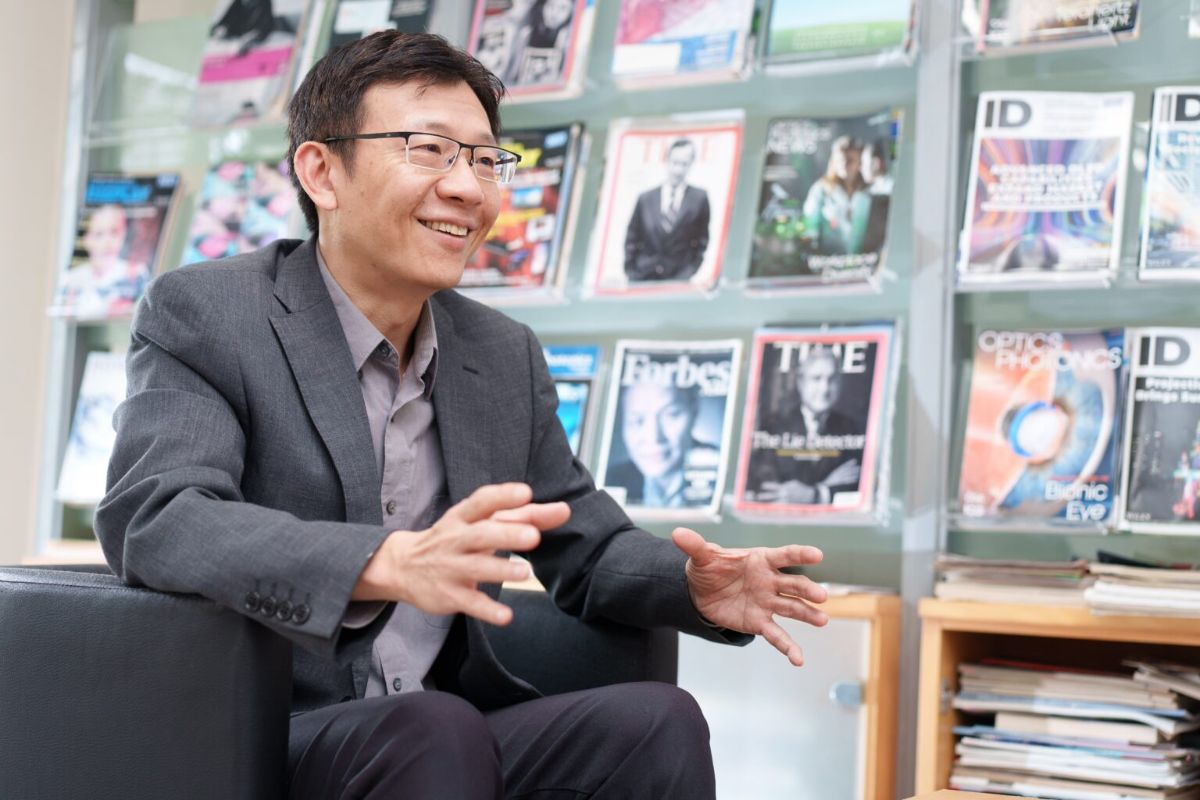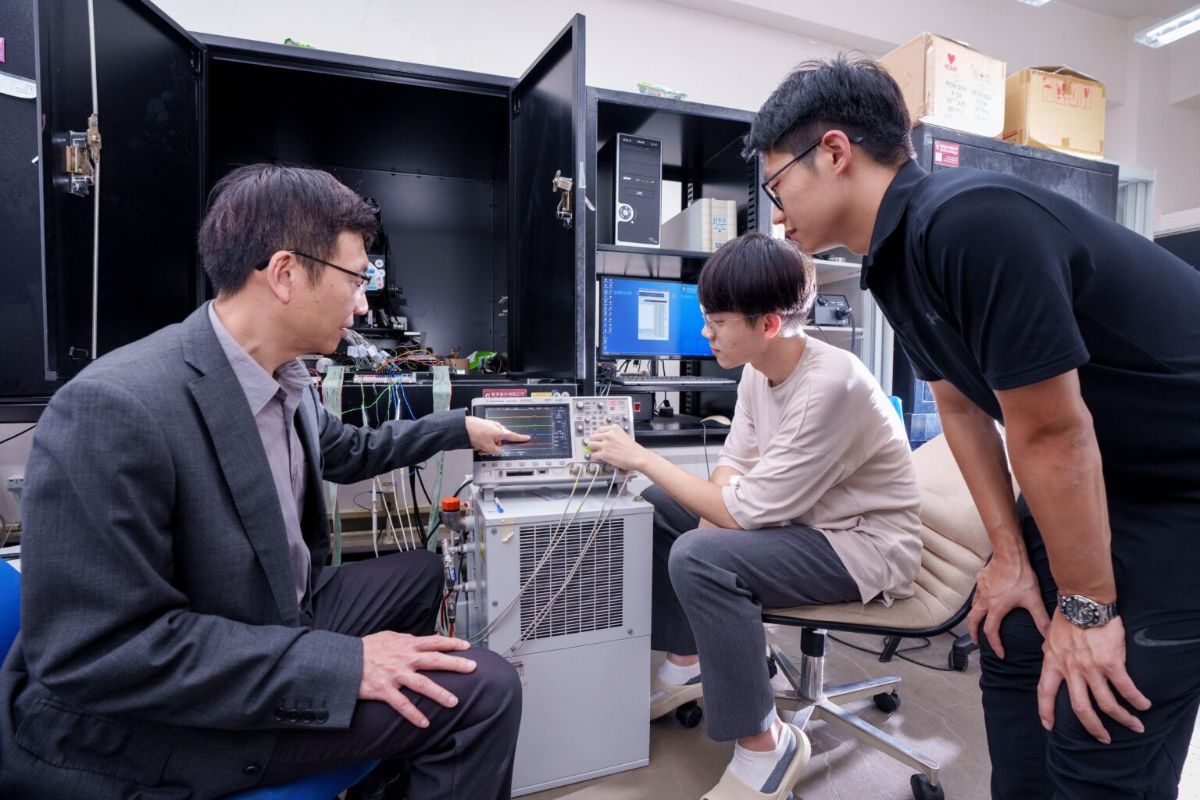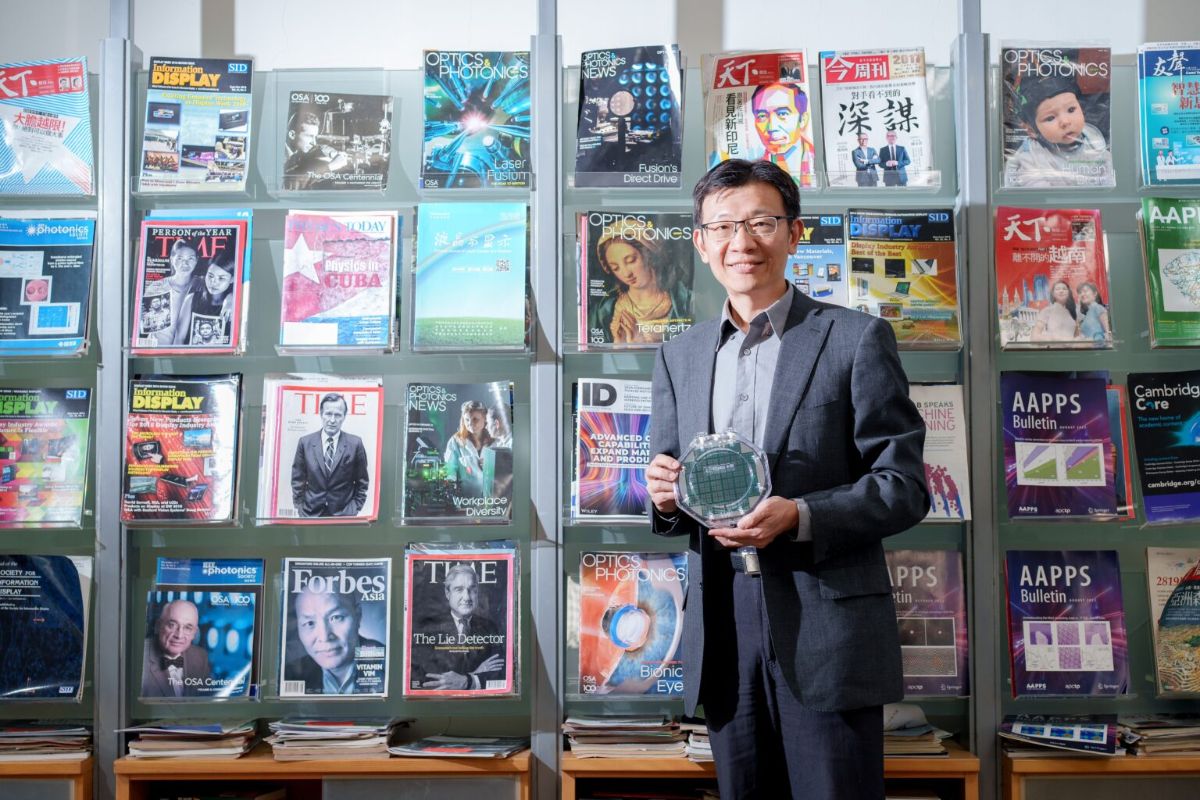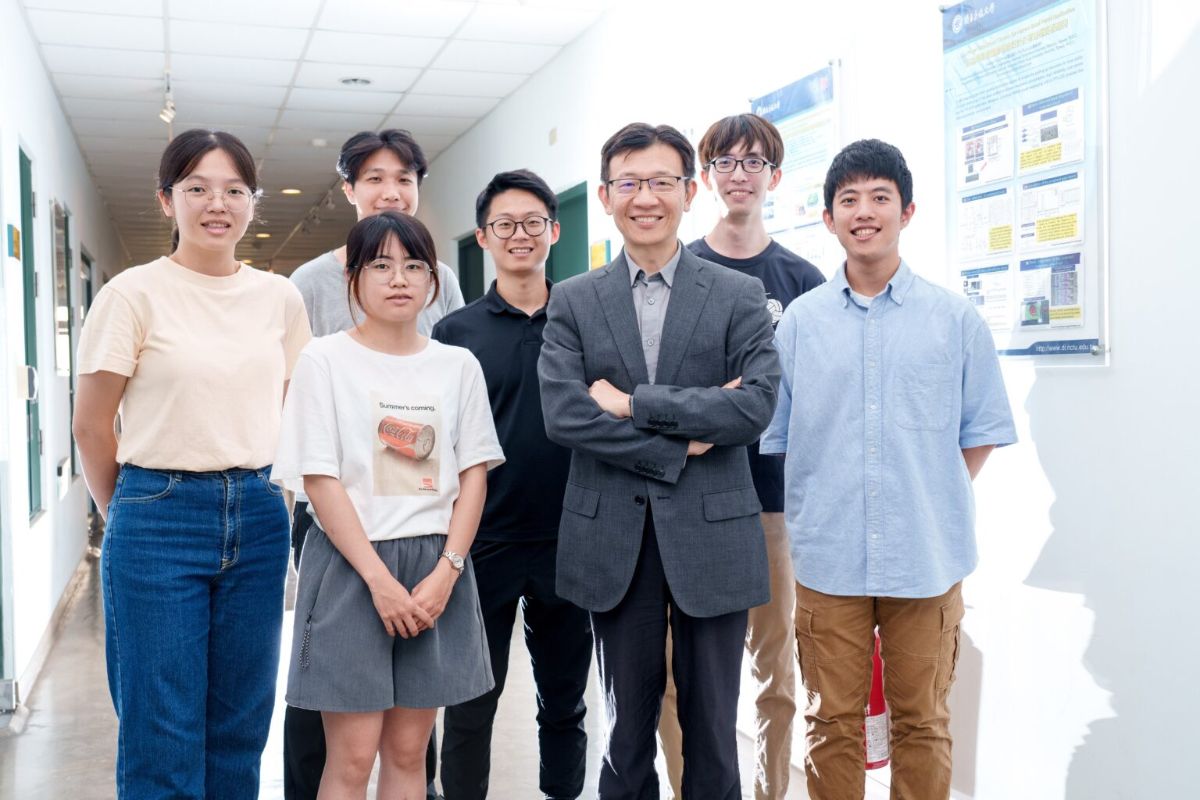RESEARCH HIGHLIGHTS
379
NYCU
Number of Academic Papers
Published by Students or Exhibition
Activities Organized by Students
- Update Date:2024-01-10
- Units:Office of International Promotion and Outreach
NYCU’s Breakthrough in Transistor Technology: Advancing Moore’s Law with Enhanced Chip Integration Density

Professor Po-Tsun Liu stated that the breakthrough in transistor technology offers hope for the continuous improvement of the density of integration of chip circuits.
By NYCU Elite
Edited by Elaine Chuang
______
Edited by Elaine Chuang
______
National Yang Ming Chiao Tung University (NYCU) has been deeply committed to advanced transistor technology research. The research team, led by Professor Po-Tsun Liu from the Department of Photonics at NYCU, has developed “Ultra High-Density Heterogeneous Complementary Field-Effect Transistor Technology” this year to challenge the next-generation technology goal of angstrom-scale integrated circuits. This achievement offers hope for the continuous improvement of the density of integration of chip circuits, and the research results have been published in the internationally renowned academic journal Advanced Science in 2023.
NYCU Leads the Way in Cutting-Edge Integrated Circuit Chip Technology with Ultra-High-Density Integration
NYCU Leads the Way in Cutting-Edge Integrated Circuit Chip Technology with Ultra-High-Density Integration
This research is part of the 'Angstrom Semiconductor Initiative,' led by Professor Po-Tsun Liu in collaboration with Yushan Fellow of the Ministry of Education, Professor Yue Kuo from Texas A&M. The focus of the research encompasses three key areas: materials, electronic devices, and circuits. More specifically, the study has pioneered the development of complementary field-effect transistor technology (CFET), designed for the application of monolithic three-dimensional integrated circuits (M3D-ICs).
According to Prof. Liu, the exponential growth of the semiconductor industry has led to an increasing demand for high-performance chips with features such as high speed, high density of integration, and low power consumption. To address the challenges posed by the physical limits of miniaturization, the concept of M3D-ICs was proposed. This involves vertically stacking multiple layers of transistor devices within a limited area, potentially surpassing Moore’s Law.
In a recent project, a team of researchers from NYCU developed a novel nanometer-thick amorphous indium tungsten oxide (a-IWO) semiconductor channel layer. They successfully implemented a complementary inverter logic circuit by combining a novel N-type amorphous indium tungsten oxide transistor with a P-type polycrystalline silicon thin-film transistor (poly-Si TFT).
According to Prof. Liu, the exponential growth of the semiconductor industry has led to an increasing demand for high-performance chips with features such as high speed, high density of integration, and low power consumption. To address the challenges posed by the physical limits of miniaturization, the concept of M3D-ICs was proposed. This involves vertically stacking multiple layers of transistor devices within a limited area, potentially surpassing Moore’s Law.
In a recent project, a team of researchers from NYCU developed a novel nanometer-thick amorphous indium tungsten oxide (a-IWO) semiconductor channel layer. They successfully implemented a complementary inverter logic circuit by combining a novel N-type amorphous indium tungsten oxide transistor with a P-type polycrystalline silicon thin-film transistor (poly-Si TFT).

Professor Po-Tsun Liu discussed experimental data with the laboratory team.
The inverter circuit is renowned for its high voltage gain, low power consumption, and high noise margin. By employing a three-dimensional stacking structure, this circuit substantially reduces the area occupied by devices, thereby effectively enhancing the integration density of transistor devices and circuits.
In a recent study, the research team successfully integrated heterogeneous semiconductor channel materials, low-temperature polycrystalline silicon, and indium tungsten oxide channel transistors to create a CFET-based inverter circuit. This innovative development showcases the technology's potential applications in M3D-ICs.
"If we integrate this atomically thin oxide transistor with front-end-of-line devices for three-dimensional integrated circuit technology, it could boost the transistor density on the chip and enhance chip functionality to meet a variety of product applications. Additionally, it has the potential to advance semiconductor technology and further the trajectory of Moore’s Law," said Prof. Liu.
The three-dimensional integration technology of heterogeneous semiconductor devices enables CFET to achieve high voltage gain under low operating voltage. It is well-suited for various low-power consumption applications, such as AIoT intelligent networks, driver ICs, wearable electronics, display panels, and the metaverse-related industry chain. The CFET technology boasts higher energy efficiency, contributing to a low-carbon emission production chain, anticipating its future application in the semiconductor industry to realize the goal of a green semiconductor production chain.
In a recent study, the research team successfully integrated heterogeneous semiconductor channel materials, low-temperature polycrystalline silicon, and indium tungsten oxide channel transistors to create a CFET-based inverter circuit. This innovative development showcases the technology's potential applications in M3D-ICs.
"If we integrate this atomically thin oxide transistor with front-end-of-line devices for three-dimensional integrated circuit technology, it could boost the transistor density on the chip and enhance chip functionality to meet a variety of product applications. Additionally, it has the potential to advance semiconductor technology and further the trajectory of Moore’s Law," said Prof. Liu.
The three-dimensional integration technology of heterogeneous semiconductor devices enables CFET to achieve high voltage gain under low operating voltage. It is well-suited for various low-power consumption applications, such as AIoT intelligent networks, driver ICs, wearable electronics, display panels, and the metaverse-related industry chain. The CFET technology boasts higher energy efficiency, contributing to a low-carbon emission production chain, anticipating its future application in the semiconductor industry to realize the goal of a green semiconductor production chain.
Intensive Collaboration with Domestic and International Scholars and Industry
The NYCU faculty collaborates extensively with domestic and international scholars, industry partners, and government agencies to enhance research and development resources. Since 2020, Prof. Liu’s team has engaged in a forward-looking collaboration with TSMC, actively participating in the Joint Development Project (JDP) focused on advancing three-dimensional transistor technology. Additionally, they are involved in international collaborations with Professor Yue Kuo from Texas A&M University, Professor Peide Ye from Purdue University, and Academician Chenming Hu from the Academia Sinica.
Currently, a cross-university team, under the guidance of Prof. Liu, is executing two phases of the 'Angstrom Semiconductor Initiative.' This team primarily focuses on developing critical technologies for high-density integrated circuits in forward-looking Monolithic Three-dimensional Integrated Circuit (M3D-IC) technologies. The initiative aims to address pressing challenges in the production technology of angstrom-scale devices and circuits, striving to achieve the performance equivalent to the 2030 1-nm node in integration density and the cost of logic and memory circuits.

Professor Po-Tsun Liu from the Department of Photonics at National Yang Ming Chiao Tung University
International Research Collaboration: Bridging Students’ Gap Between Theory and Practice
Collaboration between on-campus faculty and industry is pivotal in advancing research and technology within the field. Moreover, it offers students valuable insights into the latest technological developments in the industry, effectively bridging the gap between theoretical knowledge and practical application. Prof. Liu emphasizes, "This is why almost all graduate students from NYCU College of Electrical and Computer Engineering (ECE) secure job opportunities with Taiwan’s semiconductor industry giants even before graduation."
Furthermore, he highlighted the university’s provision of financial support and diverse international exchange programs, encouraging students to capitalize on these opportunities. Participation in such programs, he noted, not only allows students to refine their communication skills and boost their confidence but also provides them with fresh knowledge that can inspire innovative ideas.
In his closing statements, Prof. Liu reiterated the profound significance of perseverance in research. Overcoming the inclination to 'give up' forms a sturdy foundation in academic pursuits and is the singular path to success in one’s studies.
 Professor Po-Tsun Liu and the laboratory team
Professor Po-Tsun Liu and the laboratory team
International Research Collaboration: Bridging Students’ Gap Between Theory and Practice
Collaboration between on-campus faculty and industry is pivotal in advancing research and technology within the field. Moreover, it offers students valuable insights into the latest technological developments in the industry, effectively bridging the gap between theoretical knowledge and practical application. Prof. Liu emphasizes, "This is why almost all graduate students from NYCU College of Electrical and Computer Engineering (ECE) secure job opportunities with Taiwan’s semiconductor industry giants even before graduation."
Furthermore, he highlighted the university’s provision of financial support and diverse international exchange programs, encouraging students to capitalize on these opportunities. Participation in such programs, he noted, not only allows students to refine their communication skills and boost their confidence but also provides them with fresh knowledge that can inspire innovative ideas.
In his closing statements, Prof. Liu reiterated the profound significance of perseverance in research. Overcoming the inclination to 'give up' forms a sturdy foundation in academic pursuits and is the singular path to success in one’s studies.













